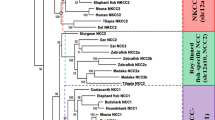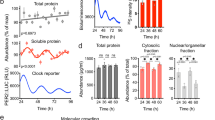Abstract
IN hibernating hamsters and ground squirrels cationic concentration gradients between tissue cells and plasma are undiminished1,2. This fact probably accounts for the ability of the excitable tissues of these species to retain high resting potentials3, to conduct action potentials3–5 and to regulate fibre water content6 at the exceptionally low body temperatures of hibernation. In most mammalian tissues at normal, high body temperature the maintenance of cationic gradients across cell membranes is an active process requiring the expenditure of metabolic energy by mechanisms which transport cations against electrochemical gradients in the face of passive leaks. The question arises whether gradients continue to exist during hibernation because these mechanisms still function or because membranes are less permeable to ions at low temperature.
This is a preview of subscription content, access via your institution
Access options
Subscribe to this journal
Receive 51 print issues and online access
$199.00 per year
only $3.90 per issue
Buy this article
- Purchase on Springer Link
- Instant access to full article PDF
Prices may be subject to local taxes which are calculated during checkout
Similar content being viewed by others
References
Eliassen, E., and Leivestad, H., Nature, 192, 459 (1961).
Willis, J. S., Science, 146, 546 (1964).
Marshall, J. M., and Willis, J. S., J. Physiol., 164, 64 (1962).
Chatfield, P. O., Battista, A. F., Lyman, C. P., and Garcia, J. P., Amer. J. Physiol., 155, 179 (1948).
Kehl, T. H., and Morrison, P. R., in Mammalian Hibernation, edit. by Lyman, C. P., and Dawe, A. R. (Museum of Comparative Zoology, Cambridge, Mass., 1960).
Willis, J. S., J. Physiol., 164, 51 (1962).
Mudge, G. H., Amer. J. Physiol., 167, 206 (1951).
Whittam, R., and Davies, R. E., Biochem. J., 55, 880 (1953).
Whittam, R., and Willis, J. S., J. Physiol., 168, 158 (1963).
Chen, K. K., Powell, C. E., and Maze, N., J. Pharm. Exp. Ther., 85, 348 (1945).
Robinson, J. R., J. Physiol., 167, 328 (1963).
Author information
Authors and Affiliations
Additional information
An erratum to this article is available at https://doi.org/10.1038/211674c0
Rights and permissions
About this article
Cite this article
WILLIS, J. Uptake of Potassium at Low Temperatures in Kidney Cortex Slices of Hibernating Mammals. Nature 204, 691–693 (1964). https://doi.org/10.1038/204691a0
Published:
Issue Date:
DOI: https://doi.org/10.1038/204691a0
Comments
By submitting a comment you agree to abide by our Terms and Community Guidelines. If you find something abusive or that does not comply with our terms or guidelines please flag it as inappropriate.



